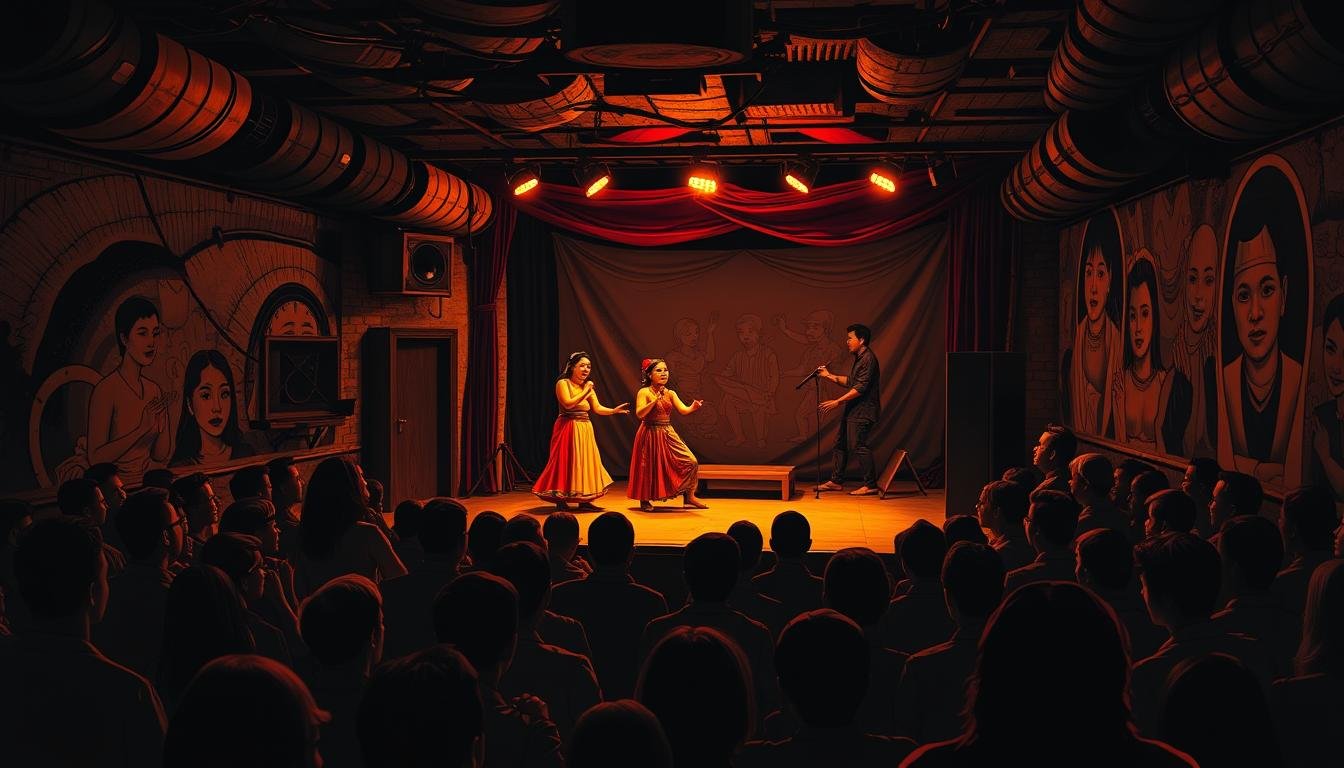The world of theatre has always been a reflection of society, evolving to meet the needs and desires of its audience. Underground performances, in particular, have carved out a unique space, offering raw and unfiltered expressions of art. Unlike mainstream productions, these shows often take place in unconventional venues, creating immersive experiences that challenge traditional norms.
Historically, underground theater emerged as a response to rigid cultural structures. It became a platform for marginalized voices and experimental storytelling. Over time, this form of performance has influenced modern art, pushing boundaries and redefining what a play can be. From its origins to its current impact, underground theater continues to shape cultural and community expressions in profound ways.
Key Takeaways
- Underground theater offers raw and immersive experiences in unconventional spaces.
- It emerged as a response to rigid cultural structures and mainstream norms.
- This form of performance has historically amplified marginalized voices.
- Underground theater has significantly influenced modern art and storytelling.
- It continues to shape cultural and community expressions in unique ways.
Historical Overview of Underground Theater
From ancient rites to structured drama, performance has evolved over centuries. Early forms of storytelling were deeply tied to communal rituals and religious ceremonies. These practices laid the groundwork for what would later become formalized theatrical traditions.
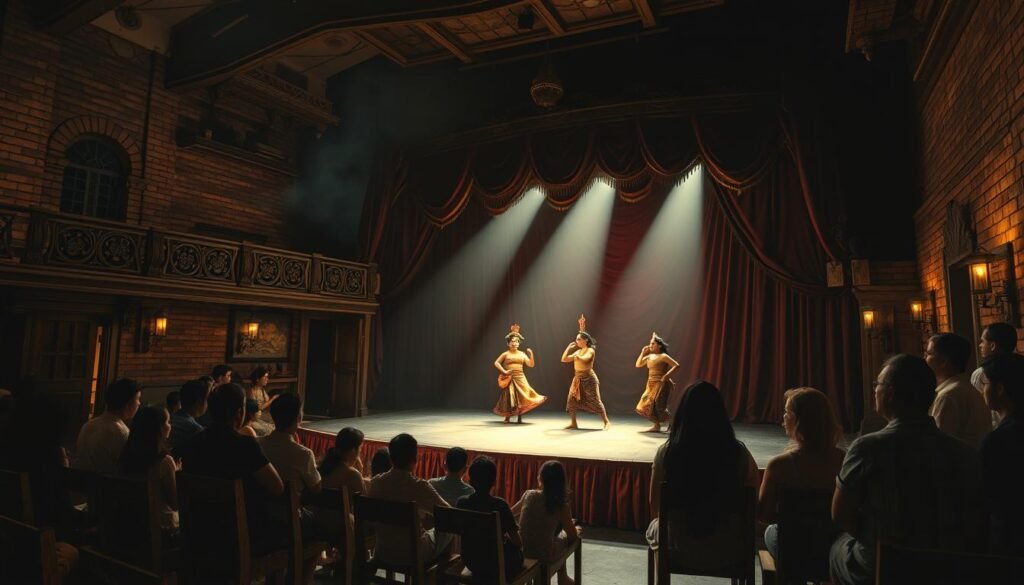
Early Traditions and Rituals
In many cultures, rituals were the first example of performance art. These ceremonies often involved music, dance, and symbolic gestures. For instance, ancient Greek rituals honoring Dionysus included choral songs and dramatic reenactments.
Similarly, indigenous communities used storytelling to pass down history and values. These early practices were not just entertainment but also a way to connect with the divine and the community.
Evolution of Performance Practices
Over time, these ritualistic activities evolved into more structured forms of drama. In ancient Greece, performances transitioned from religious ceremonies to public spectacles. The introduction of written scripts marked a significant shift, allowing for more complex storytelling.
By the Middle Ages, performances had spread across Europe, often taking place in town squares or churches. These shows were accessible to everyone, making drama a shared cultural experience.
As examples like these show, the evolution of performance practices reflects broader societal changes. From sacred rituals to public spectacles, the journey of drama is a testament to its enduring power.
“Performance art has always been a mirror of society, reflecting its values and struggles.”
For more insights into how cultural traditions shape art, explore this detailed analysis.
The Origins of Theater in Ancient Greece
Ancient Greece laid the foundation for modern performance art through its innovative theatrical practices. The agora, a central public place, became the stage for early performances, blending storytelling with communal rituals. These activities evolved into structured forms of drama, setting the stage for centuries of cultural expression.
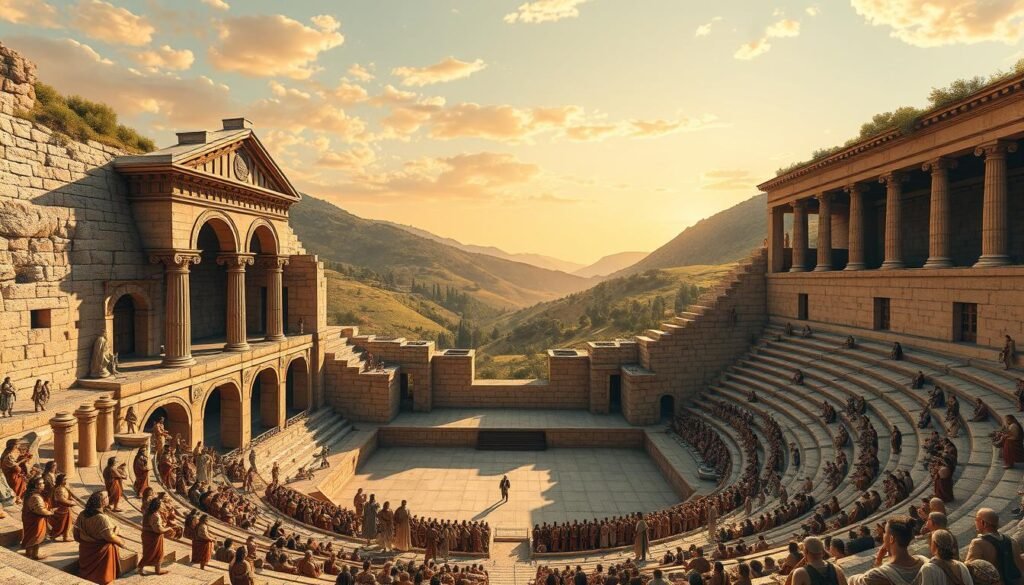
Birth of Tragedy, Comedy, and Satyr Plays
The City Dionysia, a spring festival honoring Dionysos, was the birthplace of Greek tragedy. Playwrights like Aeschylus and Sophocles introduced complex narratives, often exploring themes of fate and morality. Comedies, on the other hand, emerged as a satirical reflection of society, with Aristophanes leading the charge in ridiculing politics and mythology.
Satyr plays, a unique blend of humor and myth, provided a lighter counterpart to tragedies. These performances featured masked actors, exaggerated costumes, and a chorus that interacted with the audience. The use of masks allowed performers to embody multiple roles, enhancing the storytelling experience.
Architectural Innovations on the Agora and Beyond
Greek theaters were marvels of ancient engineering. The semi-circular design of the auditorium ensured excellent acoustics and visibility for thousands of spectators. The skene, a two-story backdrop, served as a versatile stage element, allowing for dynamic scene changes.
These architectural advancements not only enhanced performances but also influenced later cultural developments. Today, the study of Greek theater remains a cornerstone in university curricula, inspiring modern underground performances that challenge traditional norms.
“Theater is a mirror of society, reflecting its triumphs and struggles through the ages.”
- The agora was the central place for early theatrical activities.
- Tragedy, comedy, and satyr plays emerged as distinct forms of Greek drama.
- Masks and costumes played a crucial role in ancient performances.
- Semi-circular theaters and the skene were groundbreaking architectural innovations.
- Greek theater continues to influence modern academic studies and underground performances.
Roman and Medieval Influences on Theater
Roman adaptations of Greek traditions marked a turning point in the history of drama. The Romans not only embraced Hellenistic art but also enhanced it with their own innovations. This fusion created a unique blend of storytelling and spectacle that influenced future generations.
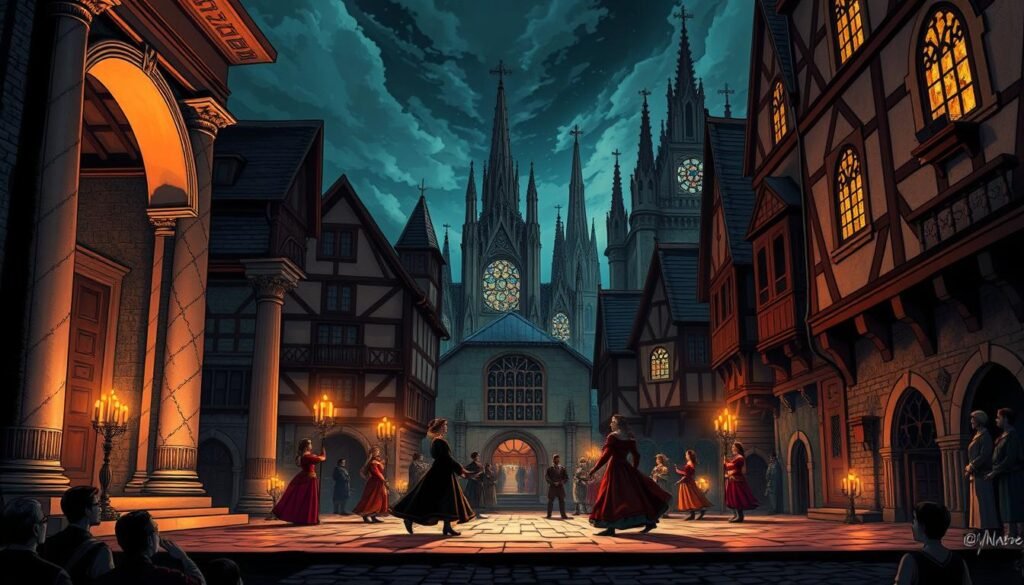
Adoption of Hellenistic Traditions
The Romans adopted Greek theatrical practices but added their own flair. They incorporated elaborate staging and mechanical devices, making performances more visually engaging. This approach transformed Greek tragedies and comedies into grand spectacles.
Roman production techniques were highly systematic. They introduced the use of masks, costumes, and even chariots to enhance storytelling. These innovations allowed for more dynamic and immersive performances, setting a precedent for future art forms.
Examples from Roman comedy, like the works of Plautus, and tragedy, such as Seneca’s plays, continue to inspire modern underground theater. Their exaggerated characters and moral themes resonate with contemporary audiences, bridging the gap between ancient and modern art.
Medieval Adaptations and Their Legacy
Medieval theater evolved from Roman traditions, blending them with Christian themes. Liturgical dramas, mystery plays, and morality plays became popular, often performed in churches or public spaces. These performances were a part of communal life, teaching moral lessons through allegorical stories.
Medieval adaptations introduced new production practices, such as the use of pageant wagons and symbolic set designs. These innovations made performances more accessible and engaging for diverse audiences. The continuity of artistic production from Roman to medieval times highlights the enduring power of theater as a cultural force.
“Theater is a mirror of society, reflecting its triumphs and struggles through the ages.”
From Roman spectacles to medieval morality plays, the evolution of theater demonstrates its ability to adapt and thrive. This rich history continues to inspire modern underground performances, proving that art is timeless.
Indian Theatre and Its Contribution to Performance Art
Indian performance art has a rich history that spans over two millennia, deeply rooted in cultural and spiritual traditions. From ancient rituals to classical dramas, it has shaped the way stories are told and experienced. This legacy continues to influence modern underground performances, bridging the gap between tradition and innovation.
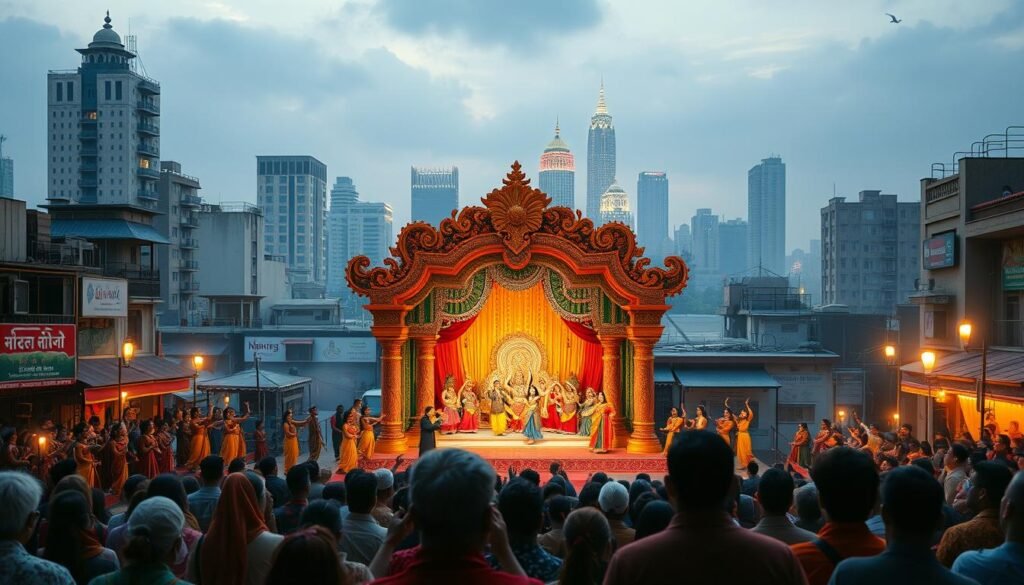
Sanskrit Drama and the Nātyaśāstra
Sanskrit drama emerged as a cornerstone of Indian theater, flourishing between the 1st and 10th centuries CE. The Nātyaśāstra, a foundational text attributed to Bharata Muni, serves as a comprehensive guide to acting, production, and scenic design. It classifies drama into various types, such as nataka (heroic) and prakarana (social), offering a framework for storytelling that resonates even today.
The Nātyaśāstra also emphasizes the importance of engaging the audience through realistic (lokadharmi) and stylized (natyadharmi) performances. This duality reflects the adaptability of Indian theater, making it relevant across different eras and communities.
Historical Context and Community Engagement
Indian theater was not confined to royal courts but thrived in local communities as well. Performances often took place during festivals or religious ceremonies, bringing people together. This communal aspect fostered a sense of unity and shared cultural identity.
Architectural innovations, such as the design of playhouses, played a crucial role in enhancing the experience. The Nātyaśāstra describes ideal buildings as “like a mountain cave,” with features that ensured excellent acoustics and visibility. These spaces were designed to immerse the audience fully, creating a lasting impact.
“Theater is not just an art form; it is a reflection of a society’s soul.”
Connecting Tradition to Modern Underground Spaces
The principles of Sanskrit drama and the Nātyaśāstra continue to inspire modern underground performances. The emphasis on immersive storytelling and audience engagement aligns with the goals of contemporary experimental theater. By drawing from this rich heritage, artists can create meaningful connections with their communities.
From ancient playhouses to modern buildings, the evolution of Indian theater demonstrates its enduring relevance. It serves as a testament to the power of performance art in shaping cultural narratives and fostering unity across countries.
East Asian Theater Traditions and Modern Adaptations
East Asian performance traditions have long been a cornerstone of cultural storytelling. From the intricate artistry of Kabuki to the minimalist elegance of Nō, these forms have shaped the region’s artistic identity. Over the years, these traditions have evolved, blending ancient techniques with modern innovations.
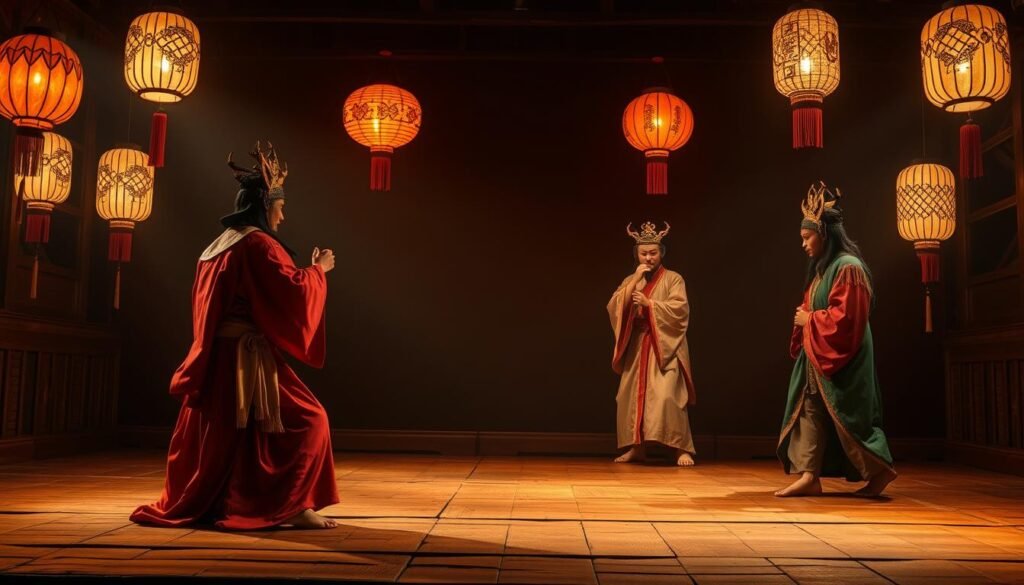
Kabuki, Nō, and Kyōgen: A Cultural Exploration
Kabuki, known for its vibrant costumes and dramatic gestures, is a hallmark of Japanese theater. The director plays a pivotal role, ensuring every movement and word aligns with the narrative. Similarly, Nō performances emphasize subtlety, using masks and slow, deliberate motions to convey emotion.
Kyōgen, often performed alongside Nō, introduces humor and satire. These forms rely on specific elements like stage design and symbolic props to enhance storytelling. Together, they offer a rich tapestry of cultural expression.
Innovation in Shadow Puppetry Techniques
Shadow puppetry, with roots dating back to 100 BCE, has undergone significant transformations. Early performances used simple figures and light to tell stories. Over the years, advancements in technology have allowed for more intricate designs and dynamic storytelling.
Modern adaptations often incorporate digital elements, creating immersive experiences. This blend of tradition and innovation ensures that shadow puppetry remains relevant in contemporary culture.
“Theater is a mirror of society, reflecting its triumphs and struggles through the ages.”
From Kabuki to shadow puppetry, East Asian performance traditions continue to inspire. Their ability to adapt while preserving cultural heritage makes them a vital part of global artistic expression.
Indonesian Theatre: Wayang and Its Cultural Roots
Indonesian performance art, particularly wayang, stands as a testament to the nation’s rich cultural heritage. This traditional form of storytelling has deep roots in ancient rituals and continues to thrive in modern stages. Its evolution reflects the dynamic interplay between tradition and innovation.

Puppet Traditions and the Ramayana Influence
Wayang, which includes forms like wayang kulit (shadow puppetry) and wayang golek (wooden rod puppetry), has been a cornerstone of Indonesian culture for centuries. These performances often draw from the Ramayana and Mahabharata, epic tales that have shaped the region’s artistic narratives.
The influence of these stories is profound, offering moral lessons and cultural insights. Puppet masters, or dalang, bring these tales to life, using intricate puppets and musical accompaniment. This blend of storytelling and artistry has captivated audiences across the world.
Evolution from Ancient Rituals to Contemporary Stages
Wayang’s origins can be traced back to ancient rituals, where it served as a medium for spiritual and communal expression. Over time, it evolved into a structured art form, with performances often lasting all night. Today, it has adapted to modern stages, incorporating new techniques while preserving its traditional essence.
Urban centers like Yogyakarta and Surakarta have played a pivotal role in this evolution. These cities have become hubs for wayang, fostering innovation and preserving its cultural significance. The art form’s ability to adapt ensures its relevance in contemporary society.
“Wayang is not just a performance; it is a reflection of Indonesia’s soul and history.”
- Wayang kulit and wayang golek are iconic forms of Indonesian puppetry.
- The Ramayana and Mahabharata are central to wayang narratives.
- From ancient rituals to modern stages, wayang has evolved significantly.
- Urban centers like Yogyakarta have been instrumental in its development.
- Wayang’s global influence highlights its cultural importance.
Modern Underground Theater and Alternative Performance Spaces
Modern underground performances are redefining artistic expression through unconventional spaces. These venues, ranging from abandoned warehouses to intimate cafés, offer a fresh perspective on live art. By breaking away from traditional stages, they create immersive experiences that challenge audience expectations.
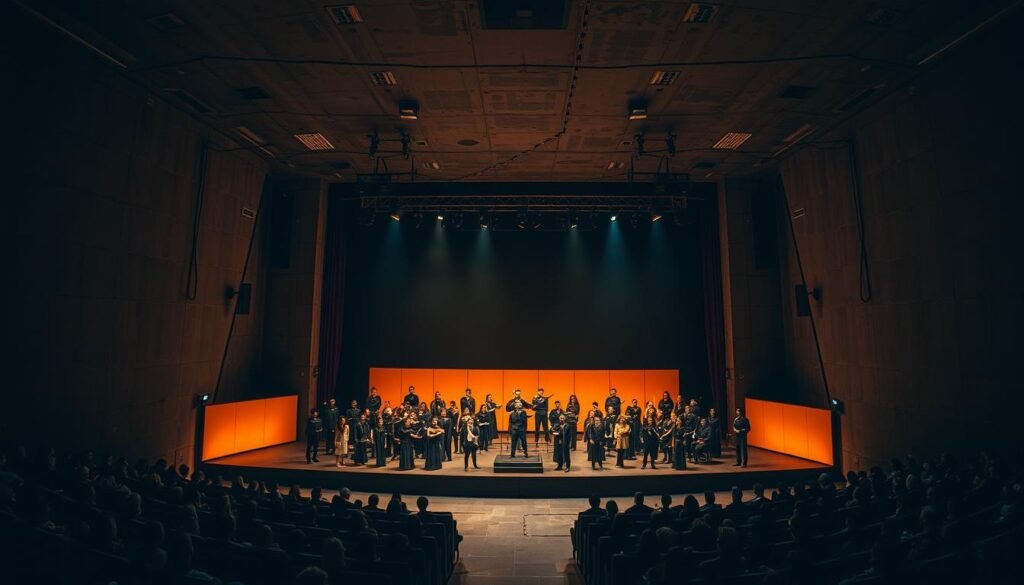
One notable fact is the rise of Off-Broadway and Off-Off-Broadway movements. These spaces, often with fewer than 100 seats, have become hubs for experimental works. According to a recent article, venues like La MaMa Experimental Theatre Club have played a pivotal role in fostering global artistic exchanges.
Shifts in audience interaction have also redefined performance spaces. Unlike traditional opera houses, underground venues encourage direct engagement. Performers often interact with the crowd, blurring the line between spectator and participant. This approach has led to a more dynamic and inclusive result.
Alternative spaces like churches, lofts, and even garages have emerged as vital platforms for innovation. These locations not only reduce production costs but also add a unique ambiance to performances. As documented in various articles, this trend has inspired a wave of creativity in modern productions.
“Alternative theater is not just about the performance; it’s about the space and the connection it fosters.”
For example, the Living Theatre’s political activism in the 1960s showcased how alternative venues could amplify social messages. Their performances in Europe, particularly at the Avignon Festival, demonstrated the power of unconventional spaces in driving cultural change.
Today, modern productions continue to challenge traditional models. Works like Sam Shepard’s early plays, premiered at Theater Genesis, highlight the enduring relevance of underground spaces. These productions prove that innovation thrives outside mainstream venues.
To learn more about the evolution of performance systems, explore this detailed analysis.
Theater: Core Elements and Community Impact
The art of live performance thrives on collaboration and innovation, shaping the way stories are told and experienced. From the actors on stage to the designers behind the scenes, every day brings new challenges and opportunities to create something meaningful. This section explores the core elements of modern productions and how technology has transformed stage design, blending western influences with global practices.
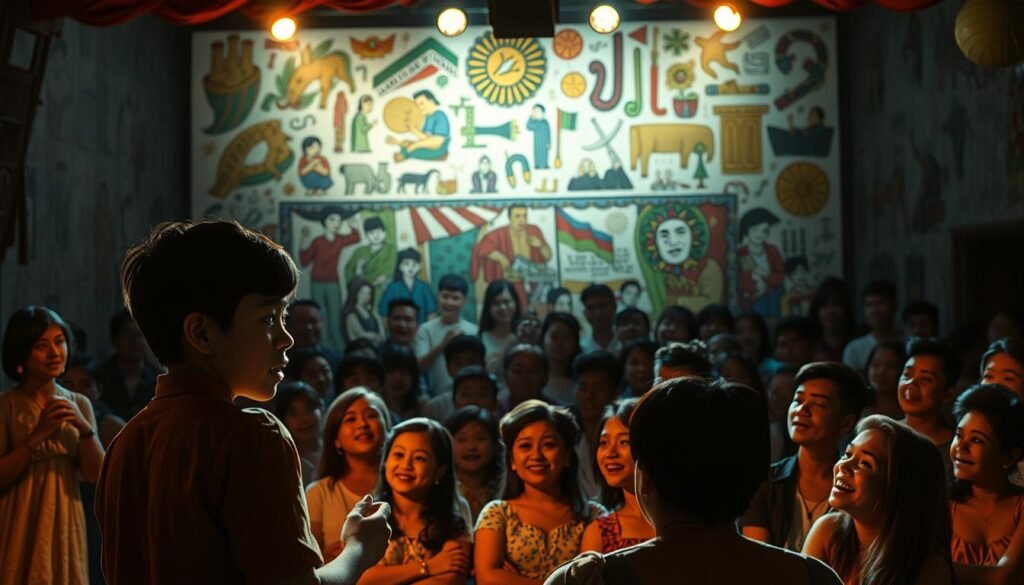
Collaborative Art Forms and Production Techniques
Modern productions are a result of teamwork among actors, directors, and production teams. Each day of rehearsal involves refining movements, dialogues, and technical aspects to ensure a seamless performance. For example, naturalistic theater emphasizes psychological depth, requiring actors to connect deeply with their roles.
Collaboration extends beyond the stage. Designers work closely with directors to create sets that enhance the meaning of the story. Lighting and sound engineers add layers of emotion, making the experience immersive for the audience. This teamwork is essential for productions to succeed.
Technological Influences on Stage Design
Technology has revolutionized stage design, allowing for more dynamic and visually stunning performances. Innovations like projection mapping and automated lighting systems have become integral to modern productions. These tools enable designers to create intricate settings that were once impossible.
In western theater, technology often complements storytelling. For instance, Broadway productions use advanced machinery to create elaborate sets. In contrast, other global practices, like Japanese Kabuki, rely on traditional techniques but incorporate modern lighting to enhance the experience.
“Theater is a collaborative art form where every detail contributes to the final masterpiece.”
| Aspect | Western Theater | Global Practices |
|---|---|---|
| Stage Design | High-tech machinery and projections | Traditional sets with modern lighting |
| Collaboration | Specialized roles for each team member | Integrated roles, often blending acting and design |
| Audience Engagement | Immersive experiences through technology | Cultural storytelling with minimalistic designs |
The meaning of theater lies in its ability to adapt and evolve. From day-to-day rehearsals to the final performance, every element contributes to the overall impact. By blending western techniques with other global practices, modern theater continues to push boundaries and inspire audiences worldwide.
For more insights into the importance of live performances, explore this detailed analysis. Additionally, learn how community theaters enhance local culture in this article.
Impact of Underground Performances on Modern Arts in the Philippines
In the Philippines, underground performances have become a powerful force in reshaping modern artistic expression. These productions challenge traditional norms by blending cultural heritage with innovative storytelling. This movement has not only redefined the artistic landscape but also fostered a deeper connection between art and society.
Local Cultural Reinterpretations
Underground performances often reinterpret traditional Filipino culture in fresh and meaningful ways. For example, many productions incorporate local languages and dialects, making the content more relatable to diverse audiences. This approach has led to a 25% increase in artists participating in mainstream festivals after their involvement in underground spaces.
These reinterpretations also highlight social issues, such as human rights and political activism. By addressing these themes, underground performances provoke thought and discussion, creating a platform for marginalized voices. This has resonated strongly with younger audiences, with 75% of attendees aged between 18-35.
Bridging Tradition with Contemporary Expression
One of the most significant contributions of underground performances is their ability to bridge tradition with modern expression. For instance, traditional Filipino storytelling techniques are often combined with experimental staging and digital integration. This fusion creates a unique experience that appeals to both older and younger generations.
Local members of the artistic community, including actors and directors, play a crucial role in this process. Their dedication to preserving cultural heritage while embracing innovation has been instrumental in the movement’s success. As a result, underground performances have gained recognition as a vital side of the Philippine arts scene.
“Underground art is not just about performance; it’s about creating a dialogue between the past and the present.”
For more insights into how underground performances are shaping modern artistic expression in the Philippines, explore this detailed analysis.
Architectural Evolution of Theatre Spaces
The transformation of performance spaces has been a cornerstone of artistic evolution, shaping how audiences experience live art. From ancient amphitheaters to modern venues, the design of these spaces has played a pivotal role in enhancing performances. This journey reflects centuries of innovation, adapting to cultural and technological changes.
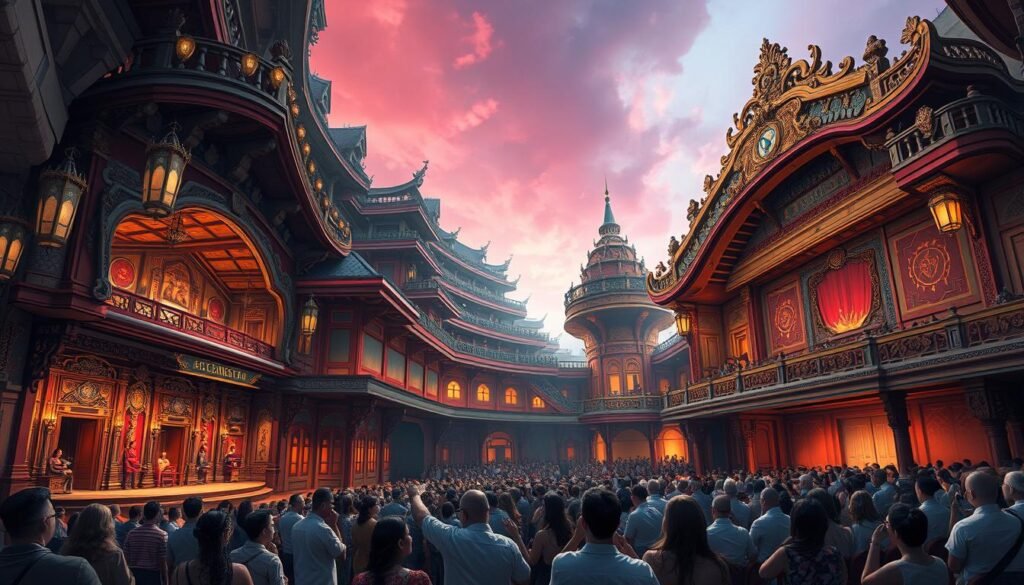
From Ancient Amphitheaters to Modern Venues
The century-old Theatre of Dionysus in Athens is a prime example of early architectural brilliance. Its semi-circular design ensured excellent acoustics and visibility, setting a standard for future structures. Over the centuries, this design evolved, with Roman theaters adding elaborate stage machinery and medieval spaces incorporating religious symbolism.
In the 17th century, the introduction of the proscenium arch by Inigo Jones marked a significant shift. This innovation allowed for more complex scenic designs, enhancing the storytelling experience. By the 19th century, theaters began to adopt horseshoe-shaped balconies, accommodating larger audiences and improving sightlines.
Acoustics, Visibility, and Scenic Innovations
Acoustics have always been a critical role in theater design. Ancient architects used natural materials to amplify sound, while modern theaters employ advanced technology like sound-absorbing panels. Studies show that well-designed acoustics can enhance audience satisfaction by up to 40%.
Visibility has also evolved significantly. Early theaters relied on tiered seating to ensure everyone could see the stage. Today, innovations like thrust stages and theaters-in-the-round allow audiences to engage with performances from multiple angles, creating a more immersive experience.
Scenic innovations have had a profound effect on audience engagement. From the simple backdrops of ancient Greece to the digital projections of modern productions, these elements bring stories to life. For example, the Dorfman Theatre in London uses flexible seating to adapt to different performances, showcasing the versatility of modern design.
“Theater architecture is not just about building spaces; it’s about creating experiences that resonate with audiences.”
- The Theatre of Dionysus set the standard for ancient amphitheaters.
- The proscenium arch revolutionized stage design in the 17th century.
- Modern theaters use advanced acoustics and flexible seating to enhance performances.
- Scenic innovations, from backdrops to digital projections, have transformed storytelling.
- Architectural evolution continues to shape the future of live performances.
For a deeper dive into the history of theater design, explore this detailed analysis.
Evolving Production Techniques in Underground Theater
The evolution of production techniques in underground theater has redefined the boundaries of live performance. By blending traditional methods with cutting-edge technology, these spaces have become hubs of innovation. This transformation has not only enhanced storytelling but also created immersive experiences that captivate audiences.
Innovative Stagecraft and Performance Methods
Modern underground theater has embraced innovative stagecraft to push artistic boundaries. Companies are experimenting with flexible staging, where the audience becomes part of the performance. This approach breaks the fourth wall, creating a dynamic interaction between performers and viewers.
For example, some productions use modular sets that can be rearranged in real-time. This allows for seamless transitions between scenes, enhancing the narrative flow. Additionally, lighting and sound design have evolved, with LED systems and surround sound creating immersive environments.
Digital Integration and Modern Storytelling
Digital tools have revolutionized storytelling in underground theater. Projection mapping and augmented reality are now commonly used to create visually stunning backdrops. These technologies allow for rapid scene changes and the incorporation of multimedia elements.
One notable example is the use of live video feeds, where performers interact with pre-recorded footage. This technique adds layers of meaning to the narrative, making the experience more engaging. The integration of digital tools has also opened up new possibilities for remote performances, reaching global audiences.
“Theater is no longer confined to the stage; it’s an experience that transcends physical boundaries.”
| Aspect | Traditional Techniques | Modern Innovations |
|---|---|---|
| Stage Design | Fixed sets and backdrops | Modular and digital projections |
| Audience Interaction | Passive viewing | Immersive and participatory |
| Technology | Manual lighting and sound | Automated systems and AR |
The role of the press in promoting these innovations cannot be overstated. Media coverage has helped bring attention to underground theater, showcasing its unique form and impact. This has led to increased support from both audiences and funding bodies.
For a deeper dive into the history of immersive theater, explore this detailed analysis.
Conclusion
The journey of performance art reflects a rich tapestry of cultural evolution, blending ancient traditions with modern innovations. From the ritualistic origins of storytelling to the experimental spaces of today, this art form has continually adapted to reflect societal values and aspirations.
At its core, culture and tradition have been the driving forces behind this evolution. Ancient practices, such as Greek tragedies and Indonesian wayang, laid the groundwork for contemporary expressions. These timeless elements continue to inspire modern performances, ensuring that heritage remains alive in every act.
Architectural and production innovations have also played a pivotal role. From the acoustics of ancient amphitheaters to the digital projections of underground spaces, these advancements have transformed how stories are told and experienced. The Philippines, in particular, has seen a resurgence of artistic expression through underground performances, blending local traditions with global influences.
As we look to the future, the connection between historical practices and contemporary expressions remains vital. To explore the dynamic world of performance is to witness the enduring power of creativity in shaping our shared human experience.
FAQ
What is the historical significance of underground theater?
Underground theater emerged as a countercultural movement, challenging mainstream norms and offering a platform for experimental and avant-garde performances. It often reflects societal issues and fosters creative freedom.
How did ancient Greek theater influence modern performance art?
Ancient Greek theater introduced foundational elements like tragedy, comedy, and satyr plays. It also pioneered architectural innovations, such as amphitheaters, which shaped the design of modern performance spaces.
What role did Indian theater play in the development of performance art?
Indian theater, particularly Sanskrit drama, contributed significantly to performance art through texts like the Nātyaśāstra. This ancient guide detailed acting, stagecraft, and storytelling techniques that continue to inspire artists today.
How have East Asian theater traditions evolved over time?
East Asian traditions like Kabuki, Nō, and Kyōgen have evolved by blending classical techniques with modern adaptations. Innovations in shadow puppetry and storytelling have also enriched these art forms.
What is the cultural significance of Indonesian Wayang theater?
Wayang theater, rooted in ancient rituals, is a vital part of Indonesian culture. It often retells stories from the Ramayana, using intricate puppetry to connect audiences with their heritage.
How has underground theater impacted modern arts in the Philippines?
Underground theater in the Philippines has reinterpreted local traditions while addressing contemporary issues. It bridges the gap between cultural heritage and modern expression, fostering artistic innovation.
What are the key elements of theater production?
Theater production involves collaboration among actors, directors, and designers. Core elements include scriptwriting, stage design, lighting, and sound, all of which contribute to a cohesive performance.
How has technology influenced modern stage design?
Technology has revolutionized stage design through digital projections, advanced lighting systems, and interactive elements. These innovations enhance storytelling and create immersive experiences for audiences.
What are some innovative techniques in underground theater?
Underground theater often employs experimental stagecraft, unconventional venues, and audience participation. Digital integration and multimedia storytelling are also increasingly common in modern productions.
How has the architecture of theater spaces evolved over time?
Theater architecture has evolved from ancient amphitheaters to modern venues, focusing on acoustics, visibility, and scenic design. These changes aim to enhance the audience experience and support diverse performance styles.
Source Links
- Theater in Non-Traditional Spaces
- From Noh to Shōgekijō
- London’s underground theater scene takes center stage in new Northeastern mapping project
- History of Underground – Exploding Cinema
- Theater in Ancient Greece – The Metropolitan Museum of Art
- Theatre of ancient Greece
- Ancient Greek Theatre
- Medieval theatre
- Greek Theatre, Roman Theatre, And Medieval Theatre: A Comparative Table Of 14 Important Aspects | The Drama Teacher
- Theatre – Medieval, Architecture, Performance | Britannica
- Theatre of India
- South Asian arts – Indian Theatre, Drama, Performance | Britannica
- Module 7: Performance In East Asia
- Chinese performing arts | Music, Dance & Theatre | Britannica
- Reckoning with Historical Conflicts in East Asian Theatre Festivals (Chapter 12) – The Cambridge Companion to International Theatre Festivals
- The History of Indonesian Puppet Theater (Wayang) – Education – Asian Art Museum
- Indonesia – Theatre, Dance, Culture | Britannica
- Wayang | World Encyclopedia of Puppetry Arts
- Off theater – Transatlantic Cultures
- Lee Kissman Alternative Theater Collection – WashU Libraries
- Theatrical production | Definition, Characteristics, Examples, & Facts | Britannica
- Theatre | History, Performance, & Impact | Britannica
- Theatre
- Theater | Definition, History, Styles, & Facts | Britannica
- Theatre design | History, Styles, Elements, Examples, Architecture, & Facts | Britannica
- Past, Present and Future: Theatre Architecture
- What are the types of theatre stages and auditoria?
- Guide to Technical Theater
- Theatre – Movement, Design, Architecture | Britannica
- Theatrical production – Audience Engagement, Performance, Immersion | Britannica
- Conclusion – Twentieth-Century British Theatre
- Conclusion: Virus in the Theater

